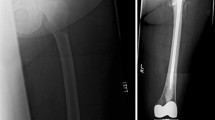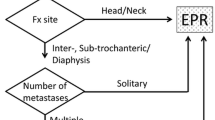Abstract
Background
Successful treatment of pathologic femur fractures can preserve a patient’s independence and quality of life. The choice of implant depends on several disease- and patient-specific variables; however, its durability must generally match the patient’s estimated life expectancy. Failures do occur, however, it is unclear which implants are associated with greater risk of failure.
Questions/Purposes
We evaluated patients with femoral metastases in whom implants failed to determine (1) the rate of reoperation; (2) the timing of and most common causes for failure; and (3) incidence of perioperative complications and death.
Methods
From a prospectively collected registry, we identified 93 patients operated on for failed treatment of femoral metastases from 1990 to 2010. We excluded five patients who subsequently underwent amputations leaving 88 who underwent salvage procedures. These included intramedullary nails (n = 11), endoprostheses (n = 61), and plate fixation (n = 16). The primary outcome was reoperation after salvage treatment.
Results
Seventeen of the 88 patients (19%) required subsequent reoperation a median of 10 months (interquartile range, 4–14) from the time of salvage surgery: 15 for material failure, one for local progression of tumor, and one for a combination of these. Five patients died within 4 weeks of surgery. Although perioperative complications were higher in the endoprosthesis group and dislocations occurred, overall treatment failures after salvage surgery were lower in the that group (four of 61) compared the group with plate fixation (eight of 16) and intramedullary nail groups (five of 11).
Conclusions
Despite relatively common perioperative complications, salvage using endoprostheses may be associated with fewer treatment failures as compared with internal fixation.
Level of Evidence
Level III, therapeutic study. See Guidelines for Authors for a complete description of levels of evidence.


Similar content being viewed by others
References
American Cancer Society global cancer facts and figures. Available at: www.cancer.org/Research/CancerFactsFigures/GlobalCancerFactsFigures/global-facts-figures-2nd-ed. Accessed January 2012.
Bauer HC, Wedin R. Survival after surgery for spinal and extremity metastases. Prognostication in 241 patients. Acta Orthop Scand. 1995;66:143–146.
Chandrasekar CR, Grimer RJ, Carter SR, Tillman RM, Abudu A, Buckley L. Modular endoprosthetic replacement for tumours of the proximal femur. J Bone Joint Surg Br. 2009;91:108–112.
Clohisy DR, Le CT, Cheng EY, Dykes DC, Thompson RCJ. Evaluation of the feasibility of and results of measuring health-status changes in patients undergoing surgical treatment for skeletal metastases. J Orthop Res. 2000;18:1–9.
Dindo D, Demartines N, Clavien PA. Classification of surgical complications: a new proposal with evaluation in a cohort of 6336 patients and results of a survey. Ann Surg. 2004;240:205.
Forsberg JA, Eberhardt J, Boland PJ, Wedin R, Healey JH. Estimating survival in patients with operable skeletal metastases: an application of a Bayesian belief network. PloS One. 2011;6:e19956.
Harrington KD, Sim FH, Enis JE, Johnston JO, Diok HM, Gristina AG. Methylmethacrylate as an adjunct in internal fixation of pathological fractures. Experience with three hundred and seventy-five cases. J Bone Joint Surg Am. 1976;58:1047–1055.
Jacofsky DJ, Haidukewych GJ, Zhang H, Sim FH. Complications and results of arthroplasty for salvage of failed treatment of malignant pathologic fractures of the hip. Clin Orthop Relat Res. 2004;427:52–56.
Lane JM, Sculco TP, Zolan S. Treatment of pathological fractures of the hip by endoprosthetic replacement. J Bone Joint Surg Am. 1980;62:954–959.
Nathan SS, Healey JH, Mellano D, Hoang B, Lewis I, Morris CD, Athanasian EA, Boland PJ. Survival in patients operated on for pathologic fracture: implications for end-of-life orthopedic care. J Clin Oncol. 2005;23:6072–6082.
Nilsson J, Gustafson P. Surgery for metastatic lesions of the femur: good outcome after 245 operations in 216 patients. Injury. 2008;39:404–410.
Potter BK, Chow VE, Adams SC, Letson GD, Temple HT. Endoprosthetic proximal femur replacement: metastatic versus primary tumors. Surg Oncol. 2009;18:343–349.
Sarahrudi K, Greitbauer M, Platzer P, Hausmann JT, Heinz T, Vecsei V. Surgical treatment of metastatic fractures of the femur: a retrospective analysis of 142 patients. J Trauma. 2009;66:1158–1163.
Schulman KL, Kohles J. Economic burden of metastatic bone disease in the US. Cancer. 2007;109:2334–2342.
Springer BD, Fehring TK, Griffin WL, Odum SM, Masonis JL. Why revision total hip arthroplasty fails. Clin Orthop Relat Res. 2009;467:166–173.
Steensma M, Boland PJ, Morris CD, Athanasian E, Healey JH. Endoprosthetic treatment is more durable for pathologic proximal femur fractures. Clin Orthop Relat Res. 2011;470:920–926.
Ward WG, Holsenbeck S, Dorey FJ, Spang J, Howe D. Metastatic disease of the femur: surgical treatment. Clin Orthop Relat Res. 2003;415(Suppl):S230–244.
Wedin R, Bauer HC. Surgical treatment of skeletal metastatic lesions of the proximal femur: endoprosthesis or reconstruction nail? J Bone Joint Surg Br. 2005;87:1653–1657.
Wedin R, Bauer HC, Wersall P. Failures after operation for skeletal metastatic lesions of long bones. Clin Orthop Relat Res. 1999;128–139.
Wedin R, Hansen BH, Laitinen M, Trovik C, Zaikova O, Bergh P, Kalen A, Schwarz-Lausten G, von Steyern FV, Walloe A, Keller J, Weiss RJ. Complications and survival after surgical treatment of 214 metastatic lesions of the humerus. J Shoulder Elbow Surg. 2012;21:1045–1055.
Author information
Authors and Affiliations
Corresponding author
Additional information
Each author certifies that he or she, or a member of his or her immediate family, has no funding or commercial associations (eg, consultancies, stock ownership, equity interest, patent/licensing arrangements, etc) that might pose a conflict of interest in connection with the submitted article.
All ICMJE Conflict of Interest Forms for authors and Clinical Orthopaedics and Related Research editors and board members are on file with the publication and can be viewed on request.
Clinical Orthopaedics and Related Research neither advocates nor endorses the use of any treatment, drug, or device. Readers are encouraged to always seek additional information, including FDA-approval status, of any drug or device prior to clinical use.
This work was performed at the Karolinska University Hospital, Stockholm, Sweden.
About this article
Cite this article
Forsberg, J.A., Wedin, R. & Bauer, H. Which Implant Is Best After Failed Treatment for Pathologic Femur Fractures?. Clin Orthop Relat Res 471, 735–740 (2013). https://doi.org/10.1007/s11999-012-2558-2
Published:
Issue Date:
DOI: https://doi.org/10.1007/s11999-012-2558-2




